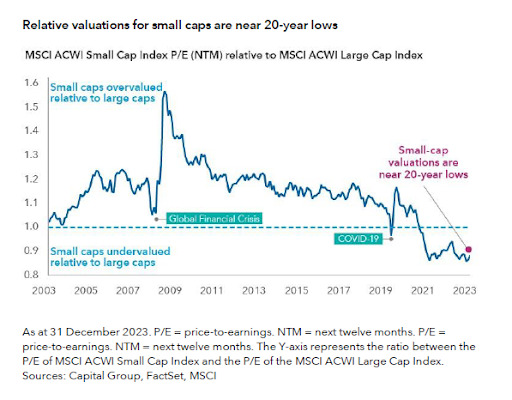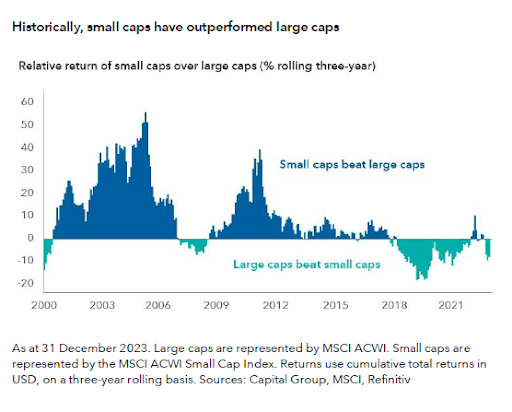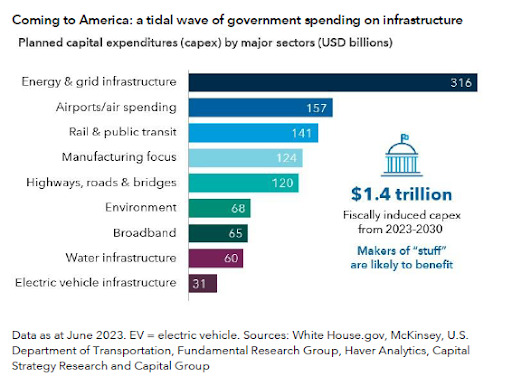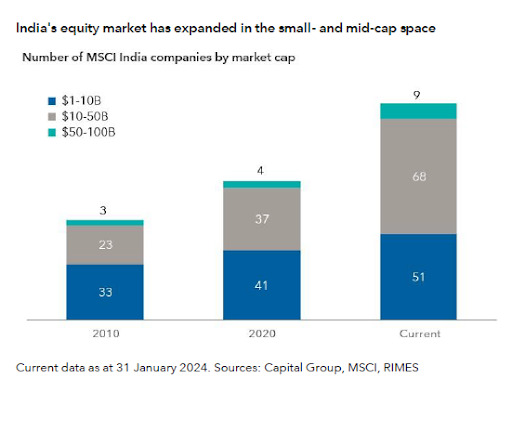Small Cap Opportunities in 2024

3 APR, 2024

Authors: Dimitrije M. Mitrinovic, Roz Hongsaranagon y Arun Swaminathan, equity managers at Capital Group
Over the last couple of years, the gap in both returns and valuations between small-cap and large-cap stocks has expanded against the backdrop of tighter monetary policy, higher interest rates and fears of a global economic slowdown.

The MSCI ACWI Small-Cap Index is trading near a 20-year low on a relative basis versus large caps. Now, as the Federal Reserve (Fed) appears to be pivoting to a more dovish stance, potentially leading to an easing of financial conditions, the outlook for small cap stocks is brightening.
The path for small cap companies, or those with a market value of US$6 billion or less, to obtain financing should be easier. And the initial public offering (IPO) pipeline, which had shrivelled to a trickle, should start to flow again, providing a fresh set of opportunities.
That said, a supportive macro-economic backdrop is only part of the overall story for small-cap stocks. These companies often need a structural growth runway to thrive. And many of the opportunities can be quite idiosyncratic or specific to each company.
Small-cap stocks also tend to be associated with the US, the largest category in this asset class. But we are finding an increasing number of opportunities around the world, in markets that one might not typically think of as havens for smaller innovative growth companies, such as Japan, the Nordic countries of Sweden and Norway, southern European countries such as Greece, and prominent Asian markets, notably India.
And despite lagging large caps in recent years, smaller companies have been an important source of return in global equity markets. They have outpaced their larger brethren close to 70% of the time in rolling three-year periods since 2000.
In this article, we highlight areas of opportunity that we find illustrate the multifaceted and dynamic nature of the global small-cap space.
- Growing tailwinds from global infrastructure build.
- European industrial rollups offer compelling business models.
- AI evolution presents opportunities.
- India is a fertile ground for small caps.
- Greek banks provide unique opportunity.
- Biotechnology may bounce back.
- The IPO market may thaw with reasonably deals
Growing tailwinds from global infrastructure build
Heating systems, insulation products and trucking companies are not glamorous businesses when compared to the sizzling world of artificial intelligence (AI) and the latest tech innovations. Yet, these nuts-and-bolts industrial companies are getting much of our attention.

Deteriorating US infrastructure and government willingness to upgrade it – from electric grids to pipelines, combined with a desire by companies to have better security around supply chains – has brought new life to the industrial complex.
Significant investments from governments and multinationals are expected to be a source of sustained demand in the years ahead. The US government, for instance, has committed US$1.4 trillion over the next seven years to rebuild America's infrastructure and reshape the manufacturing, semiconductor and energy industries.
Of interest are businesses that supply heating, ventilation and air conditioning system installation services (HVAC). This is an area of growth where smaller companies have carved out market share and hard-to-replicate distribution networks, affording them pricing power.
For example, Comfort Systems, one of the larger HVAC companies in the US market, has reported a robust pipeline of projects tied to new semiconductor, computer data centre and electric vehicle battery plants. Its US$4.3 billion backlog as at 30 September 2023 was US$1 billion higher than the same 2022 period. This is not just a US phenomenon. HVAC firms based in Italy and Switzerland have benefited from Europe's push to make more buildings and homes energy efficient.
European industrial rollups offer compelling business models
We are finding that European industrials, especially in the Nordic countries, that utilise mergers and acquisitions (M&A) can be true value creators. Acquisitive industrial firms that roll up companies under one hood have shown they can profitably scale, providing compelling total returns over longer periods through a combination of dividends, organic growth and acquired earnings from M&A.
These companies aim to create value for shareholders through smart capital allocation and growing their business through either vertical or horizontal expansion. Their philosophy is quite simple: They usually acquire companies with under US$10 million of annual revenue for less than 10 times earnings before taxes and interest. After the acquisition, they keep these businesses independent of each other in a decentralized operating model.

Given their deal sizes are small, these roll up industrial firms face less competition from private equity buyers and can pay lower valuation multiples. This business model is more prevalent in Europe relative to the US, which has a greater pool of buyers among private equity shops and hedge funds, who tend to put greater emphasis on financial efficiency over synergy among like businesses.
AI evolution presents opportunities
The evolution of AI applications will have a significant impact across industries. Since the technology is still in the early stages, we are being selective. Among the businesses that stand to benefit from AI’s initial development are suppliers to the semiconductor industry as well as information technology (IT) services firms.
One is the production of specialised chemicals, gases and adhesives used in semiconductor production and packaging, particularly for memory and datacentre server chips. A few Japanese companies dominate this area. These are monopolistic-like businesses that will be hard to dislodge. Overall, AI is driving growth in the global semiconductor industry as high-performance computing chips are needed to power AI-applications and reduce heat in data centres.
IT services companies are seeing increased work for AI-related projects as large corporations spend to upgrade existing technology. For example, Argentina's Globant SA, which works in 30 countries and whose clients include Google and Walt Disney, recently noted that 'AI will be the dominant growth driver in the IT services market.' It said demand was high for AI-driven experiences across industries.
IT services firms are likely to benefit near term, but in the long run they may be more challenged, especially if AI displaces software engineers employed by the IT service companies.
India is a fertile ground for small caps
India's booming economy, growing housing market and digital infrastructure make the country an attractive hunting ground to identify fast growing companies. The range of opportunities within India's small-cap landscape has expanded as pro-business and market reforms have gained traction, helping to facilitate the expansion of credit and formalise the economy.
Significant government investment in infrastructure, increasing domestic consumption and India's rise as an alternative to China for manufacturing mobile phones, home appliances and computers has steadily broadened the opportunity set. These range from beverage producers to chemical suppliers to building products companies and private hospital operators. There are also more prospects in the financial sector, with a new crop of wealth management firms, home mortgage lenders and mobile-based consumer finance platforms. We've also seen an increase in the number of small and mid-sized companies listing their shares on public equity markets.

The challenge is that valuations in aggregate appear stretched. India's stock market is trading at record highs and valuations have gotten expensive in some cases. The MSCI India Index traded at 21.7 times forward earnings versus its 10- year average of 18.8 times (as at 30 January). We remain selective but also recognise that this is a high growth market. For these reasons, we believe it's important to do bottom-up research to sift through these opportunities.
Greek banks provide unique opportunity
Greece has undergone a remarkable transformation after running into severe debt troubles that required three financial bailouts from 2012 to 2015. Today the country is no longer in financial distress. Greece is one of Europe's fastest growing economies following a series of reforms under its pro-market government, and its sovereign debt has been upgraded to investment grade (BBB/Baa and above) by credit rating agencies.
The country's commercial banking market is vastly different, having shrunk from roughly 25 banks to a handful today. The banks are over-capitalised and there's less competition for loans, which has resulted in a low-cost deposit base compared with other European countries. Overall, Greek banks trade at attractive valuations on a relative basis and there's potential for dividends, which could boost total stock returns.
By contrast, we find small-cap US banks more challenged, especially after the 2023 collapse of Silicon Valley Bank and a few other regionals. Many are overexposed to commercial real estate, have higher deposit funding costs versus the large banks and are constrained to invest in new technologies.
Biotechnology may bounce back
We may be at a trough for valuations in the biotechnology sector. Equity prices in this space tend to move with funding cycles, and if interest rates move lower, it could be a catalyst for improved sentiment. A pickup in M&A activity over the past couple of months appears to signal such a shift, and we are looking for opportunities after valuations got crushed when rates spiked. While the market last year was fascinated by the potential for obesity drugs, we believe the innovation and product cycle is vibrant for other kinds of drugs to treat a range of diseases. Alzheimer's is one such area. Another potential growth area is in companies that supply specialised tools and materials needed by global pharmaceutical giants.
The IPO market may thaw with reasonably priced deals
The IPO market may yield opportunities to selectively invest in promising companies at reasonable valuations. With expectations that major global central banks are nearing the end of a rate-hiking cycle, there is hope that IPO activity can rebound after a quiet couple of years.
Historically, we have found that following periods of diminished IPOs, higher quality companies with better-run businesses and prospects are often the first ones brought to market by investment banks. These deals are usually offered at more palatable valuations versus times when the IPO market is red hot and less mature companies can tap the markets.
In 2023, we also saw a geographical shift in the IPO market. Deal activity was stronger in faster-growing emerging markets. India, Saudi Arabia and Thailand all posted an increase in the number of deals, with Indonesia and Turkey climbing above the five-year average.
Related articles
 This is how the deposits that the Argentarii, the ‘bankers’ of Ancient Rome, offered to their clients worked
This is how the deposits that the Argentarii, the ‘bankers’ of Ancient Rome, offered to their clients workedBy RankiaPro Europe

